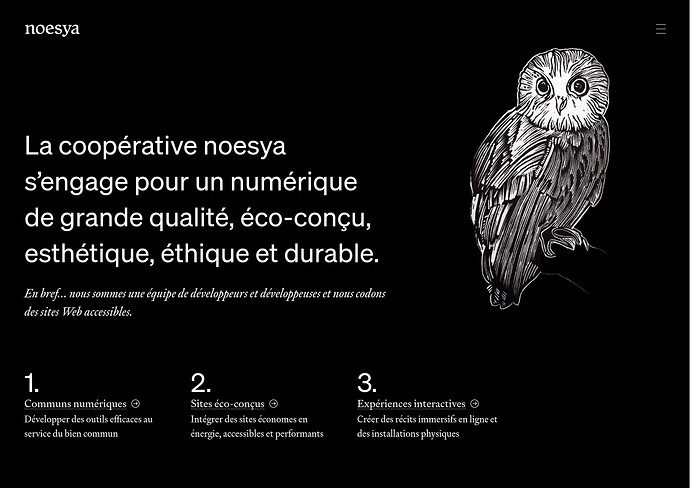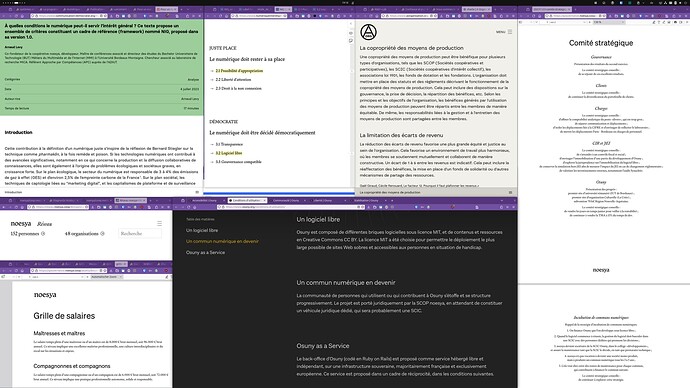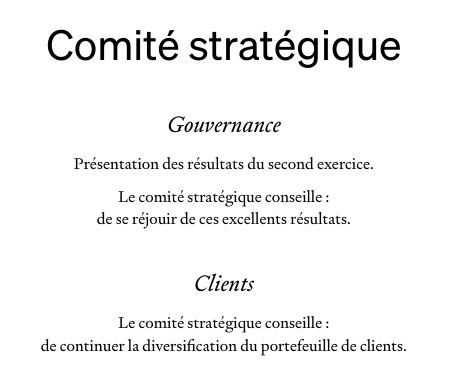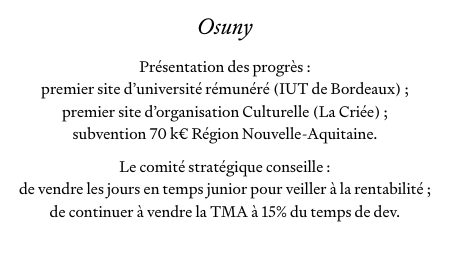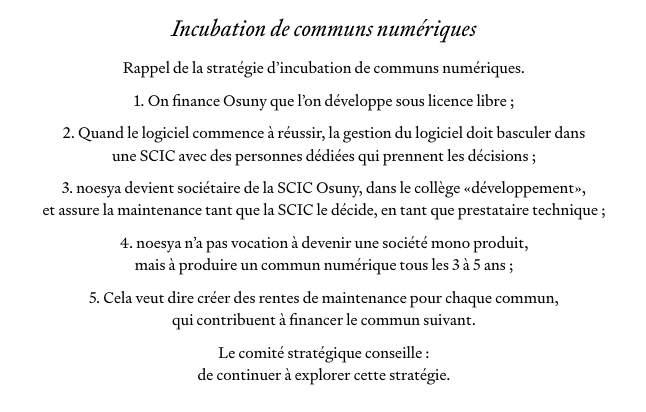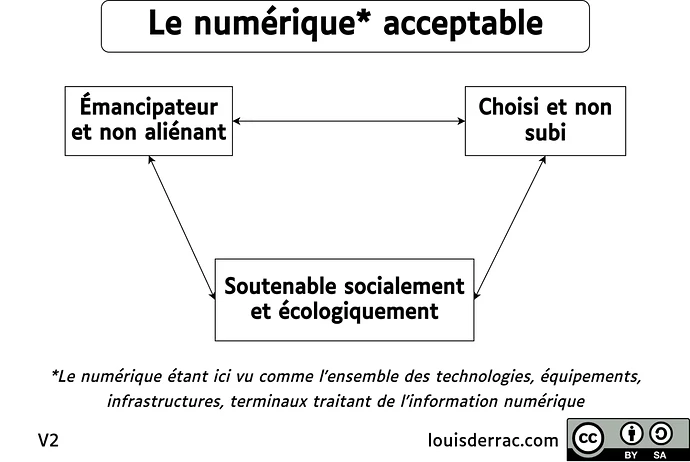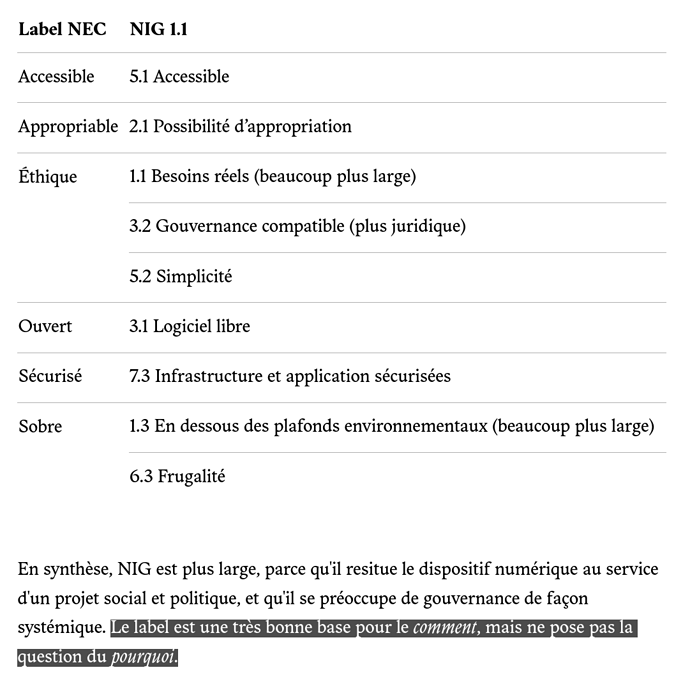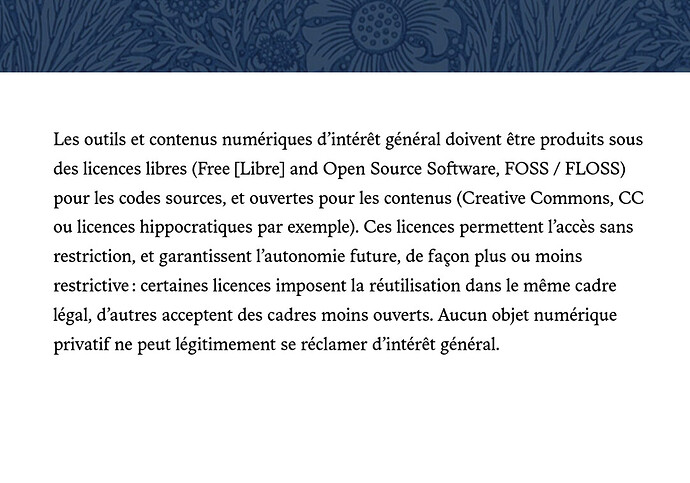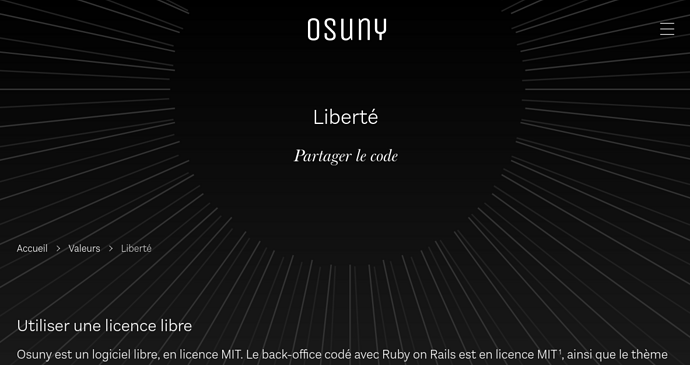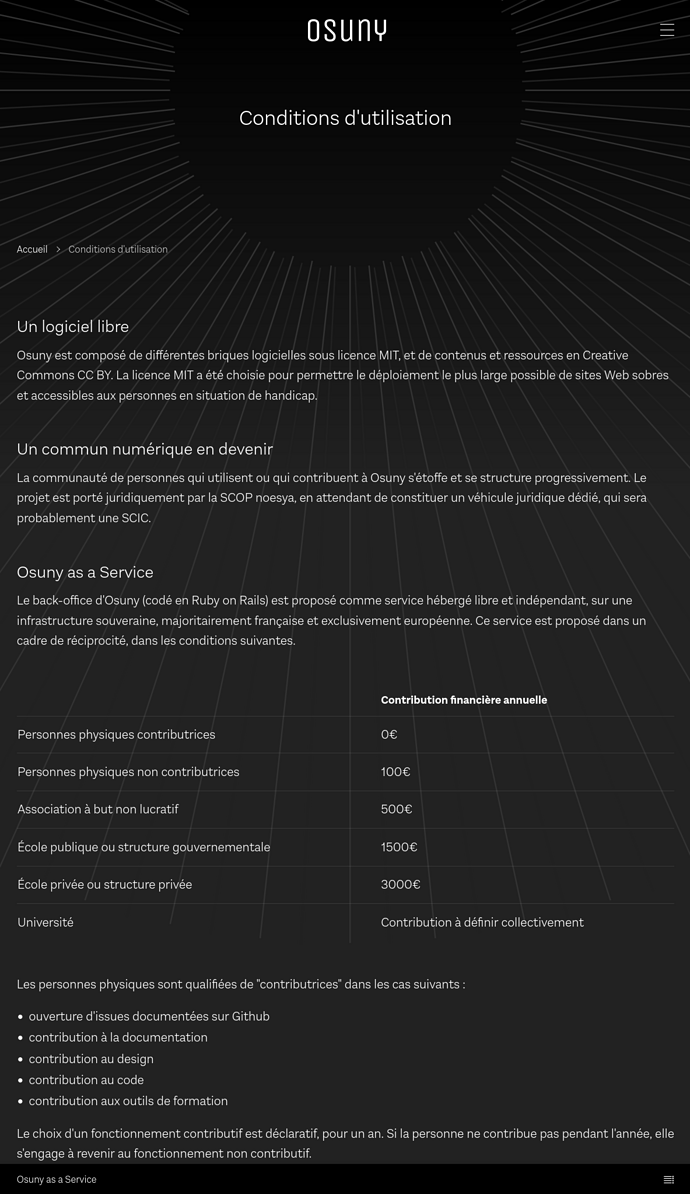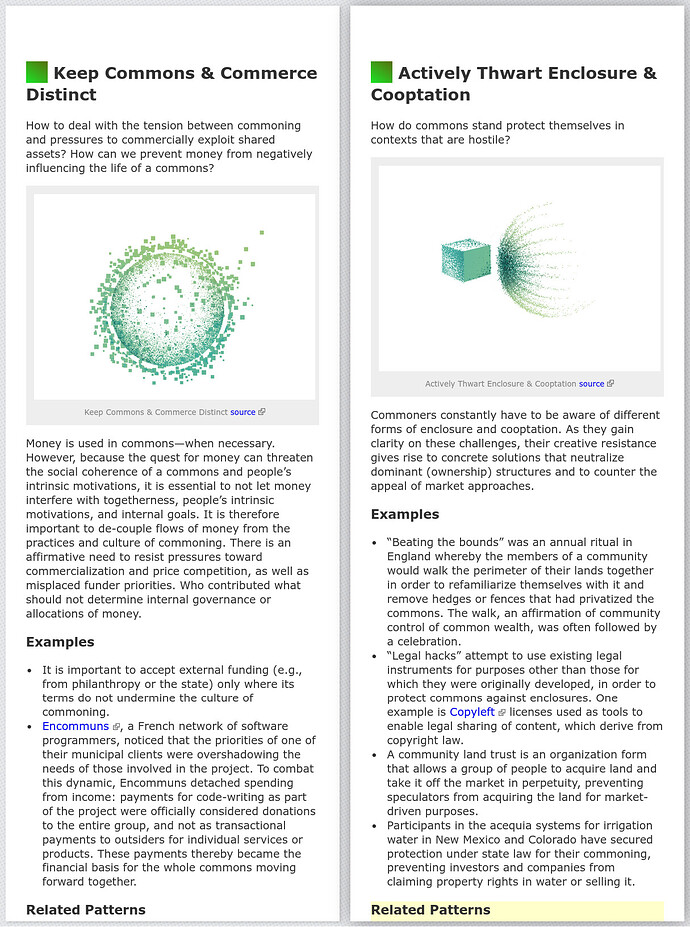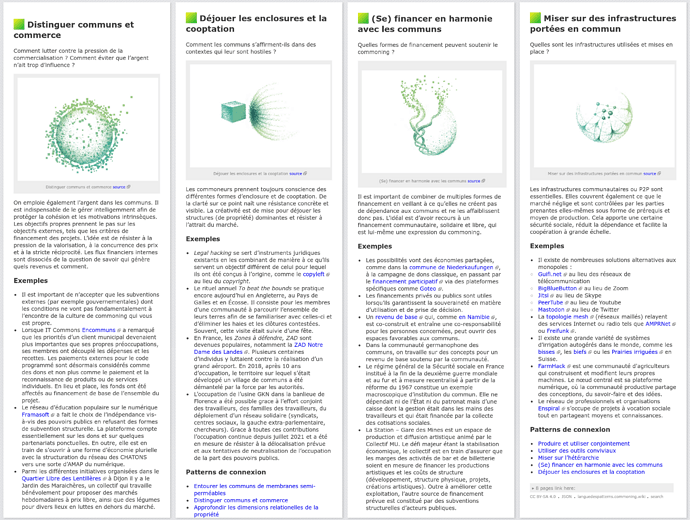The consideration of Ergonomy of development experience and common reproducibility questions around maintaining degrowth.net have incurred a little enquiry into the means of operation at Noesya with regards to the apparent focus on commoning of computational media. This post documents a critical reading of published material and seeks to evaluate the question, how much Commons there is in Osuny and Noesya.
Seen from the entrance page noesya.coop, it is the priority one objective of the organisation:
- Computational Commons. Develop suitable tools to serve the Commons.
As first sketched in the linked thread, there is plenty of activity and material in the spheres of Noesya and the large Osuny community. It is largely French speaking and spreads from government institutions to informal initiatives and private concerns. Many activities are described in very accessible form, using the very system to openly publish documents, articles, reports, codes, directories of people and organisations up to political manifests and a certification programme for evaluating computational Commons.
To understand better which forces are at play in this large environment, allow me to dive a bit into the presented for retracing the paths and drawing the lines that allow to cluster the major narrative strains and domains.
Most of these publications where found after inspecting the website footer and by indirectly hitting them via the website code repositories at noesya · GitHub. The ones below are being put in focus for excerption and commentary.
Language disclaimer: I’m writing this with a secondary language that is not my primary language. The writing will mostly also be received by non-native speakers. It is also a colonial and hegemonic language. J’aimer passer la parole en français un autre jour. Pour l’instant j’utilise ma langue de travail, qui est la lingua franca de la domaine de la numérique. Die Indirektion über eine Fremdsprache birgt immer ein Restrisiko des Missverständnisses. Aber was wäre eine Sprache, die nicht zu deren Überwindung taugt?
It is a large corpus of documentary and discursive material that is available, which is in general a good thing. With this wealth of information presented in so many different locations, it is also a bit challenging to comprehend the inner workings of the community and its many ideas and outputs.
But a grand « Chapeau! » to what is made available to the public here.
Now let’s look a bit closer at Noesya to ask how they relate themselves to the Osuny Common.
Publicly available governance documentation contains a reference to a pretty recent strategic communiquée from 2023-11-23 by a Comité stratégique comprised of six people.
Comité stratégique
The document states strategic recommendations to make regarding several subjects of noesya’s work.
For example at the top they reflect on their Governance role and present the first strategic domain, Clients:
Not so far below, the document also brings up Osuny:
It seems to be a viable source of income for the organisation, given the paragraph speaks a lot about subvention and rates for selling service.
For what interests us here, further down the document also has a special section about the Incubation of computational commons:
In summary, the cooperative will finance Osuny, which is developed under a libre license. When this works well, it is outsourced into a separate legal body and established in a cooperative model with shared-ownership. They want to follow this exit-to-community plan every three to five years with changing products. Which in turn means to create revenue for the individual projects, in order to contribute to shared maintenance of the Commons.
While it is clear and evident, that establishing and maintaining the Commons is a high value for noesya, it is also evident, that classic contractual client work also plays a large role in the activities of the cooperative. Further there seems to be a line of work in Osuny that is recognised by public funding.
Seen from this perspective, Osuny is a product by a cooperatively economising entity that is branded as a Common to produce more favourable client relationships. In this regard, the resource maintained in shared ownership, Osuny, appears to be appropriated by an economic process to produce revenue and income for its maintainers. Eventually there are aspects in the Osuny body of work that do not fall under the production logic of relations in financialised reciprocity, which tend to be more visible in such « official » documents.
Let’s look a bit further at the publications and increase our focus on how the stewardship of the cooperative creates the space for the Common to flourish.
Gouvernance
The governance page was found in the GitHub organisation and is also linked as the first item in the hamburger menu of the noesya.coop website on second sight.
The site contains a repository of documents and links to the strategic committee, which we learned about above. The documents are filed into categories about strategy, jurisdiction, economy, ecology and ethics.
Following on with the investigation, it is very easy to find regular financial reports about the activities of the organisation, which provide a good overview on the scale and dynamics of development operations.
From mere price lists for contract work and salary accords, through annual and quarterly financial reports, there is even a voluntarily signed dedication to ethical conduct in the work.
We are presented with common tariffs in the business:
We are also given a look at the annual turnover:
These documents underline the economic functioning of the cooperative for its practitioners. From the numbers, it seems to be a well-functioning affair, which gives confidence in the longevity of operations.
The undersigned Charte Numérique Responsable (![]() PDF) states a high-level commitment to all that’s good in computing and through that indirectly names a few risks that challenge the conformity to the declaration.
PDF) states a high-level commitment to all that’s good in computing and through that indirectly names a few risks that challenge the conformity to the declaration.
It especially refers to the ecological impact of electronic appliances, with some answers to reduce them, and highlights the questions of diversity and inclusion for a just participation model.
The charter does not have an understanding of the Commons nor expresses any relation to them.
Let’s inspect the other resources for finding evidence to more relatedness to common affairs.
Diagnostic
There is a nice digital intervention that calculates the discrete and physical ecological impact of a website. It’s neat and calls for more action.
Réseau
The ![]() Réseau noesya website (github) gives a nice overview of people and organisations connected with Noesya and Osuny. Its directory is grouped in categories for Research, Strategy, Design, Tech and Ethics and once again highlights the large network of practitioners connected with the cause.
Réseau noesya website (github) gives a nice overview of people and organisations connected with Noesya and Osuny. Its directory is grouped in categories for Research, Strategy, Design, Tech and Ethics and once again highlights the large network of practitioners connected with the cause.

Yet also not much word about explicit commoning efforts.
Let’s not hesitate and seek further how Noesya establishes Osuny as a Common.
Sane
One of the activities of Noesya is an action research about alternative systems & emergent norms.
The research asks hard questions about compatibility of organisations with post-growth conditions, how to build relations with other organisations, how computing can serve the common good with a special focus on interactive media for communicating ethical experience.
It’s a large research programme, which involves many organisations, cooperatives and universities,
It is summarised in these headlines:
- Bring about a political project
- Prepare organisations for the time after-growth
- Promote computing in the common interest
- Contribute to the triage state + market + commons
- Act through the action research
The programme is bold and has strong criticism in ecological and economic areas. It explicitly mentions the tensions and forces between the different operational logics of state, markets and the Commons. While it doesn’t reject the state nor markets, it offers a reinterpretation of capitalocentric logics by the view of Raworth’s Doughnut economics.
Here we want to focus on the third axis in the matrix of activities under the Sane umbrella:
To cite:
noesya participates in contributing to computing in the common interest through its productions and diverse actions. But how to define what is computing in the common interest? How to characterise it? How to distinguish the projects which serve the common good from those who are commons washing, green washing or social washing?
An ex-citing proposition to start with and good material for later reflection. For now we recognise a dedicated effort to sustain the Commons also in the field of information and communication technology (ICT). It culminates in publication of a declaration of a reference frame for computational Commons.
There is a nice article by @arnaudlevy which provides a lot more context.
Pour un numérique d’intérêt général | Communication et démocratie
![]() Lancement du site numeriqueinteretgeneral.org • sane
Lancement du site numeriqueinteretgeneral.org • sane
Let’s inspect this reference frame more thoroughly (remember, bold claims need bold evidence) and see how we can put it to good use with Osuny.
This appears to be a major culmination of year-long efforts to support the common good with solid and profound criteria to distinguish, if one is acting in the common interest, or not.
Numérique d’Intérêt Général
The first question I ask myself when reading the title of this proposal, is why it speaks of intérêt général and not of bien commun. This might be a little lost in translation, but it is nevertheless interesting. All language cultures always have space for more diversity in a given discussion.
NIG, un cadre de référence pour le Numérique d’Intérêt Général • Numérique d’Intérêt Général
The NIG, as it is called, splits up in several sections (Just ends, Just place, Democracy, Respect the law, Respect the people, Care, Sovereignty) and also seeks to be a reference frame for certification of computational Common(s). We will look at two examples from the reference frame.
Excursion: Label Numérique en Communs
For now the label is more interesting, because it provides distinct validation criteria, against which the broader narrative unfolds. it is published by the « Agence Nationale de la Cohésion des Territoires » and seeks to identify means that help the digitalisation of the regions.
Label Numérique en Commun[s] • Numérique d’Intérêt Général
General Interest and Commons are mobilised by a state actor here, to help provide bring about good conditions for a rich ecosystem. Which is basically understood as « economic opportunities » to facilitate « new collaborations » for « computational inclusion » esp. by means of « a growing emerging logic of computational Commons ». Which again sounds a lot like marketing logic.
I’m still struggling to find the Commons as I know them here, the one from the Tiers-Lieux, the AMAPs and urban agriculture, from the Pattern Language of Commoning (langue des patterns), but they can’t be far. For now what I’m finding is a lot about cooperativism, yes, and also about holding public and civic actors accountable for their actions, yes.
I may be ignorant and possibly missing the point. But wasn’t it the Commons when people get together about organising their lifes outside of the market or the state logic? Why are these so proponent here? Are we witnessing the birth of a new understanding of Commons as being compatible with quantitative economies and the resounding rule of law?
They make no mistake that openness is a main pillar of the whole operation:
Open
Having made available the computational elements in discussion (software, databases, plans, concept material, etc.) by principle in an open format and under an Open Data license.
Let’s not be distracted by the appropriation and enclosure of the Commons by the state. We continue with our reading of the NIG 1.1 • Numérique d’Intérêt Général, which was grown from its own grassroots.
2.1 Possibilité d’appropriation • Numérique d’Intérêt Général
l’articulation avec les logiciels libres permet d’envisager un numérique « choisi et non subi », « émancipateur et non aliénant » pour reprendre les termes proposés par Louis Derrac dans sa définition d’un numérique acceptable
Following the link:
The acceptable computing*
- Emancipatory and non-alienating
- Chosen and not imposed
- Socially and ecologically sustainable
*The computing is herein seen as the ensemble of technologies, equipments, infrastructures, which ultimately treat computational information
The possibility of appropriation means in this sense, that an articulation [of human affairs] with Free Software allows to imagine a different kind of compute, when these criteria are met. How can we know they are?
Let’s return to one of the points in the NIC article about the label. It was mapped to the Openness category and is point 3.2. about Free Software (before NIC v1.1 was released it was known as point 3.1).
In synthesis, NIG is larger, because it resituates the compute paradigm in service of a social and political project, and which preoccupies itself with systemic governance. The label is a very good base for the how, but it does not ask the question of the why.
The pattern is strong and prescriptive. It speaks about software, data and content tools in the general interest. Following the script, they have to be produced under Free licences, which allow for access without restriction and grant future autonomy, under more or less restrictive terms. No single privatised computational object can legitimately claim general interest.
There is a lot to unfold from this section, which we can keep for later. For now it is enough to remember that the NIG culminates in a radical prescription of granted liberties, while inviting for accountability and fair conduct with regards to environmental and social, say civic liabilities.
We’re on a brink to something here, but let’s withhold it for more appropriate timing. We still have some reading to complete.
Laboratoires - recherche et développement
Noesya also run an R&D lab, which is basically a blog of their activity in the design and advocacy fields. We can check it out to hear directly from the people.
The cooperative is also part of A, an organisation that follows another charter, against which one can get certified, too. The logo is a nod towards anarchism:
Now that we’ve gotten enough inspiration of the vibe and flair that surrounds the noesya atmosphere, let’s proceed to a practical example and examine their most prominent production.
Which brings us to the star in the manège, the Osuny common.
Osuny
I’m looking at the osuny.org website and am exploring it from the outside. My onset is to discover the application from the perspective of a systems developer within the computational commoning collective allmende.io, who is looking for a nice interface to a content API that can be used for building static web pages. Osuny shines in this area, and we are seldom shy and often happy to participate in a replication study of applying FLOSS to voiced use cases (next.allmende.io/). Publishing a website is an often heard case, and remains so, even in times of platform media. Why Osuny is even more relevant to cater for free and diverse speech in the public web.
What can Osuny offer in this regard and which guarantees does it give me to support me on this journey? Let’s find out!
The website is structured in the larger narrative arcs of Usage, Values, Functionalities, Governance, Put to action, next to policies, a blog, the directory of organisations and people, plus their meeting notes.
I’m picking some pages of interest that state the values and provide guidance on how to contribute out in the open. It has become evident that this public interest tech is rooted in a large community and sustained by a large number of clients. We should be able to find out where its open source community lives?
The community page of the website has a disclaimer at the top, which cites a famous definition of the Commons as a shared resource. It adds to it a notion of zero margin costs, which are present in disembodied and ephemeral ICT.
A common is « a resource shared by a group of people ». Computation permits to develop commons benefitting from marginal zero cost, by mutualisation of the infrastructure and the development of functionalities that benefit all. The publication in open source […] grants perpetuity of the solution. [Emphasis by the author.]
Speaking from the perspective of seeing the Common as the material residue of an encompassing and activating Commoning practice, the habit of speaking from it only as a resource has consequences on the way how maintenance and interaction are structured.
A curious visitor of the page might ask themselves: what is it that the Common does or enables, which is made possible by the act of engaging here in a not marketed, non-reciprocal relation with each other?
When speaking of the liberties attached with Osuny, the parole is again focussed on the artifacts, hence residue from the interactions that make them possible. We see licenses and program languages and libraries and others mentioned here.
The curious visitor occupied with their replication study continues to ask: How does all of this perform as running code in a replication experiment?
The stabilisation of Osuny sees it on a path to become a Common. What is stated here makes it seem, that there is a lot of background work going on in establishing new structures and bodies for sustaining its longevity by juristic, governance and technological means.
« Where is the large community in these procedures? », the interested individual asks.
I had come here to this forum to find the community and to find ways to interact with them. This is because I am an Osuny user and developer at the IDN and interested in reproducing an environment that is suitable for hosting Osuny instances. To make use of this liberty, I need access to documentation and technical specifications that help to set up a reproducible execution environment that is capable of holding all run-time components with exclusively Free Software.
At eco:bytes, who care for allmende.io and its other communities, we rely on self-hosted Free Software to avoid the vendor lock-in of and costly contracts with proprietary platforms. Being part of the Librehosters and beknown to CHATONS, I am able to infer that there may be other people who operate under similar constraints.
The reasons given by noesya for why to put computational artifacts and runtime components into the Commons are exemplary, striking and profound. Where less community-oriented operations is perceived and more service-oriented offers are presented, it does not explicitly exclude an interweaving of a bit of the open source spirit.
When we worked with EnCommuns from Lille ten years ago in the TransforMap project, we had a big discussion about how to Separate Commons and Commerce To Make It Work For the Commons (P2P Foundation Wiki). The article, from Simon Sarasin, had a nice graphic and explained why it’s worth the effort to strengthen the distinction between the two modi operandi.
This text ultimately sparked a pattern in the research of Silke Helfrich and David Bollier…
We helped Frédéric Sultan and Remix the Commons to reify it in French.
I hope you already had the pleasure with EnCommuns folks. They do a good job in decoupling their environment into the ecosystem and this way spread their roots, while providing for others.
- LSC – Legal service for commons – Structures juridiques pour soutenir les communs
- Pourquoi 3 hébergeurs ? – Collectif Point Communs
How do you think does application hosting fit into the discourse around reproduction of computational artifacts in the Common? Which are suitable modes of production, and how to provide the means? Especially when it’s funded by public sources. I’m seeing a fair chance, that cooperation with federations that control compute, like CHATONS and Librehosters, will play a meaningful role in the upcoming discussions about sovereignty and portability of public interest tech.
This last screenshot also shows the only place that I could find which occupies itself with providing guidance on how to contribute back to the project. Other examples remain hard to find.
I’m interested in learning more about how noesya sees itself and operates as an « agent commoneur », qui se comprends comme un nœud dans un réseau des communautés commun?
Or to ask stealing the words from a former colleague: What do we have in common?
After this enduring consumption of public documentation on what noesya does and in which setting Osuny is embedded into, we have good material to work with when checking the artifacts for reproducibility.
Let’s continue with our investigation on finding out how much Osuny can be made fit to meet our hypothetical expectations, and about finding obstacles to do so. Now off to the more practical hands-on part.
